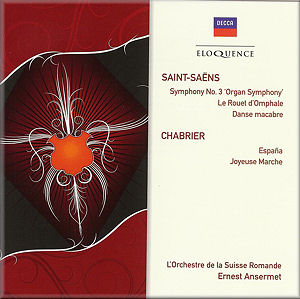 |
 |
|

AVAILABILITY
Buywell.com
|
Camille SAINT-SAËNS
(1835-1921)
Symphony no.3 in C minor, op.78 (Organ Symphony) (1886) [37:17]
Le Rouet d’Omphale, op.31 (1869) [8:50]
Danse macabre op.40 (1874) [7:20]
Emmanuel CHABRIER (1841-1894)
España - rhapsody for orchestra (1883) [6:48]
Joyeuse Marche 1888) [3:59]
 Pierre Segon (organ) Pierre Segon (organ)
L’Orchestre de la Suisse Romande/Ernest Ansermet
rec. Victoria Hall, Geneva, Switzerland; October 1952 (Saint-Saëns
opp. 31, 40; Chabrier); May 1962 (Saint-Saëns op.78). ADD
 DECCA ELOQUENCE
480 0082 [64:43] DECCA ELOQUENCE
480 0082 [64:43]
|
|
|
Some years ago I had a most interesting conversation with a hi-fi
salesman. He told me that, whenever a customer happened to mention
that he had even a passing interest in classical music, the shop
had three pieces of music on CD ready to pop into a machine to
demonstrate its capabilities.
The first was the dramatic climax to the Festival at Baghdad
finale of Rimsky-Korsakov’s Scheherazade. The
second was the opening to Richard Strauss’s Also sprach
Zarathustra which even quite knowledgeable customers usually
referred to as “the 2001 music”. And the third was
the grandiose finale to Saint-Saëns’ Third Symphony,
a piece that, so he told me, usually drew a small crowd of pop
music fans to listen as they subliminally recalled the “big
tune” from a 1977 hit record (“If I had words to
make a day for you / I'd sing a morning golden and true / I would
make this day last for all time / then fill the night deep with
moonshine...)
That story, though, makes a serious point about the many recordings
of Saint-Saëns’s blockbuster - that it has often been
marketed as a sonic experience rather than as a piece of music.
Ever since 1959 and RCA’s recording with Charles Munch and
the Boston Symphony Orchestra, the Organ symphony has been
seen as something of a sound engineer’s virility symbol.
Far from many critics questioning the musical ethics of Daniel
Barenboim’s 1970s recording in which technical boffins mixed
an orchestral contribution recorded in Chicago with Gaston Litaize’s
organ part set down weeks later and thousands of miles away in
Chartres cathedral, they generally raved about it. That recording
went on eventually to sanctification in Deutsche Grammophon’s
prestigious Originals series.
In the early 1960s Ernest Ansermet was clearly less concerned
with the fad for sonic blockbusting than with sheer, honest musicality.
Thus, while Fritz Reiner’s 1960 Chicago “Living Stereo”
version of Scheherazade was the audiophile’s choice,
those more focused purely on the music often held Ansermet’s
Suisse Romande recording from a year later to be its superior.
That contrast is exactly paralleled in the case of the Organ
Symphony. Ansermet’s version was certainly well recorded
in good, clear stereo sound - even if it was not the finest of
which Decca engineers were then capable. For that listen to the
remarkable Ataulfo Argenta/London Symphony Orchestra album España,
still sounding absolutely stunning today after 52 years. But in
no way is the Ansermet a blockbuster. Instead it can be appreciated
as well thought out, intensely musical and an account to make
one look at the symphony once again with fresh eyes; perhaps even
to take it a little more seriously than usual. Superficial excitement
is not in evidence at all: indeed, at just 37:17 Ansermet’s
careful, rather stately interpretation comes in slower than any
other recording on my shelves: Martinon from 1975 is next at 36:15;
the same conductor’s 1966 recording clocks in at 35:19;
Toscanini’s 1952 version is, perhaps surprisingly, not
the quickest at 34:45; Munch in 1959 completed his classic account
in just 34:30. The fleetest recording comes from Barenboim in
Chicago and Chartres in 1976.
This repertoire was right up Ansermet’s street and his Swiss
orchestra clearly feels quite at home too. I especially enjoyed
the witty, playful account of Danse macabre: it may just
be in mono sound but for musicality it knocks the spots off yet
another “sonic blockbuster” of that era: a Decca Phase
4 version under, I think, Stanley Black that was, forty years
ago, the first Saint-Saëns that I had ever heard. Chabrier’s
España faces stiffer competition, however, for,
confronted with the combination of a superb performance and
fabulous sound, I’d go for Argenta over Ansermet any
day.
While a perfectly worthwhile and enjoyable release - and one that
certainly adds to our appreciation of Ansermet the consummate
musician - this is not one likely to displace other recordings
of this repertoire. It may seem a sadly superficial judgement
but, in the Organ Symphony in particular, sheer sound quality
does make a difference. It means, for example, that Toscanini’s
recording is one of the few in his complete 71-CD RCA Collection
that I do not listen to for pleasure. Ansermet’s version
is clear and sharp but its comparative restraint and that missing
special “oomph” mean that we are less than likely
to hear it on the hi-fi salesman’s playlist.
Rob Maynard
|
|

